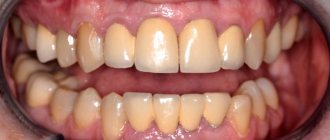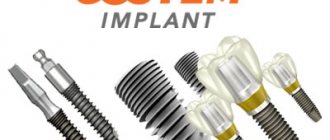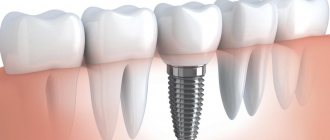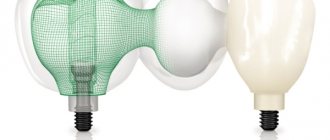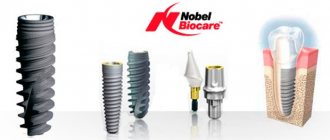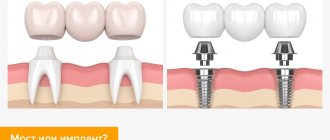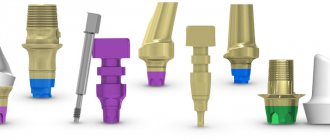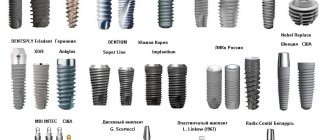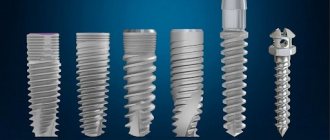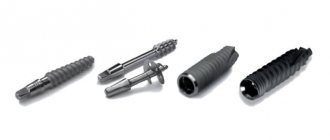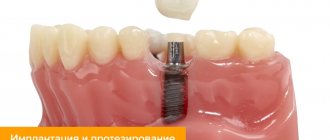The success of dental implantation consists of two main components - high-quality materials and the professional work of the doctor. In most cases, both of these factors go hand in hand, because if dentistry cares about improving the qualifications of its specialists, then it chooses implant manufacturers with the utmost care. Today, Nobel Biocare is considered one of the most popular brands in the industry. Nobel Biocare dental implants have been used all over the world for over 40 years and have a well-deserved reputation as the most reliable and safe. Let's look at why they are good and why they are used by the best world-famous clinics, together with the implant surgeon at Ilatan Dentistry in Moscow Berdzenadze Zurab Zaurievich.
Nobel dental implants: everything the average patient needs to know about them
Nobel Biocare was founded by Swedish scientist Per-Ingvar Brånemark, who discovered the phenomenon of osseointegration - the fusion of bone tissue with metal objects made of titanium - in 1952. He also carried out the first successful implantation in 1965. Then the technology continuously developed and today Nobel dental implants are widely and successfully used by dental surgeons all over the world. Today they are available with an innovative TiUnite surface, which increases the rate of osseointegration and improves the survival rate of the material, even when installed with immediate loading. The survival rate of Nobel implants is (according to the results of a number of large-scale long-term studies) from 97.1 to 99.2%.
Types of Nobel implants
Over the decades of their long and fruitful activity, Nobel Biocare specialists have studied thousands of different clinical cases and developed optimal solutions for a wide variety of situations:
- restoration of anterior or lateral teeth, on the upper or lower jaw,
- prosthetics of one tooth or the entire dentition,
- for immediate or staged implantation.
Among Nobel Biocare products, the doctor will always be able to select the appropriate implants, taking into account the structure of the jaw and the characteristics of the individual situation of each individual patient.
Nobel Active
This implant is suitable for the most difficult cases, incl. for installation in tight spaces between two remaining teeth (for example, front teeth). It can be installed in the socket of an extracted tooth, in soft bone, and is characterized by very high primary stabilization in any conditions. Due to the special structure of the root part, its position can be changed during the installation process.
The NobelActive implant has a reverse-taper neck, which stimulates the regeneration of bone and soft tissue, creating a more aesthetically pleasing artificial tooth shape. The well-designed conical shape of the implant body with cutting blades at the end ensures tighter contact with the bone, minimal trauma and accelerated osseointegration.
A specially designed conical connection with an anti-rotation hex allows for a stronger connection between the abutment and the implant and increases the stability of the prosthetic structure.
NobelReplace
This type of Nobel implant is equipped with a detailed surgical installation protocol, which significantly simplifies and speeds up the entire procedure, and the presence of 4 options helps you choose the most convenient option for any specific case. Thanks to its shape, it has high primary stabilization and can be suitable for installation with immediate loading.
NobelReplace implants are equipped with a special abutment fastening system, including 3 anti-rotation channels. All installation kit items are color coded for easy selection.
NobelReplace CC
NobelReplace Conical Connection implants are shaped like natural teeth and are equipped with a conical connection system to the abutment, which is sealed and reliable, preventing the penetration of saliva and the development of inflammatory processes. All this ensures mechanical reliability and excellent aesthetic performance of artificial teeth for any implantation method, incl. with immediate loading.
The presence of a platform change function and the well-thought-out shape of the implant determine the presence of a ledge on the installed implant with a fixed abutment - exactly in the place where the neck of a natural tooth is located. This ledge ensures the normal formation of soft gum tissue and forms a beautiful natural contour of the restored tooth.
NobelReplace Conical Connection implants have a TiUnite surface throughout the entire body, including the neck, and NobelReplace Conical Connection PMC implants have a 0.75 mm wide milled neck.
NobelParallel CC
The implants of this system have a special shape: the walls of the body are parallel to each other, and the apical (end) part is conical. This makes it possible to place such implants even in soft bone, prosthetizing both lateral and anterior teeth. You can restore one or several teeth, as well as the entire dentition.
All types of implantation are used, incl. a method with immediate loading, which places special demands on the quality of implants - their primary stability, the rate of osseointegration.
Thanks to their innovative shape, these implants can be used for bicortical fixation - to restore 3 or more lost teeth in a row. A small number of drills makes the implantation procedure faster and less traumatic.
NobelSpeedy
In fact, this is a whole line of implants of various lengths for fixation in the soft bone of the upper jaw. They allow you to perform complete fixed prosthetics using the All-on-4 system. They are characterized by high primary stabilization; even in situations with insufficient bone volume, they allow you to do without bone grafting.
The special structure of the implant body (especially its tail (apical) part) makes it possible not to completely prepare the bed, because Thanks to its unique thread, the implant itself cuts off sections of the bone, achieving improved stabilization and a tight connection with the bone tissue.
The shortened drilling protocol allows you to speed up the entire procedure and reduce treatment time, while ensuring excellent stabilization in the HTO even during implantation with immediate loading. A large selection of implant models of various lengths and thicknesses makes it easy to select options for each specific case.
NobelZygoma
Special implants that are characterized by increased length for integration into the zygomatic bone. They are specially designed for prosthetics in the upper jaw in situations with severe bone tissue atrophy, when the bone becomes so thin that the installation of conventional implants is impossible. NobelZygoma allows in these cases to do without bone grafting (for example, sinus lift), simplify and speed up the implantation procedure.
All nobel biocare implants feature the innovative rough oxidized TiUnite surface for faster and stronger integration with bone tissue, which ensures the best survival rate, and are guaranteed for life.
These implants have either a straight neck or a 45-degree curved neck, which provides greater prosthetic options, providing a wide variety of options for installing orthopedic structures. The length of the implants is from 30 to 52.5 mm, the diameter is from 3.9 to 5 mm.
Brånemark System
This is an implant system with a special connection having an external hexagon shape, which allows for more precise positioning of the abutment (6-12 positions). The internal connection has 3 channels that prevent spontaneous rotation of the abutment and facilitate its installation.
Brånemark System Mk III is designed for installation in dense and medium-density bone. The implants have parallel walls and 3 cutting chambers in the tail.
The Brånemark System Mk IV is designed for installation in soft bone. Shallow cutting chambers cause less bone trauma, providing superior primary stability.
Brånemark System Mk Shorty – short implants (5.5 mm), which allow you to do without bone grafting, even if the bone tissue is severely atrophied.
Brånemark System Zygoma – zygomatic implants of increased length, allowing the installation of implants in the upper jaw with severe atrophy of bone tissue, when it is not possible to install conventional implants.
Implants for the All-on-4® protocol
All-on-4® concept is designed for patients with complete edentia (no teeth). Such patients are fitted with a fixed full prosthesis fixed on four implants.
- Nobel Speedy Groovy – implants have a slight narrowing of the body, the apical part is equipped with cutting grooves, which allows the use of biocortical fixation. There are many different variations of this model in length and diameter;
- Nobel Zygoma – zygomatic implants have a length from 3 cm to 5.25 cm, which allows them to be installed deep into the bone and achieve a high level of primary and secondary stability. The use of zygomatic implants allows one to avoid osteoplastic intervention even in the most complex clinical cases. The implants have a diameter of 3.9 mm or 5.0 mm, the neck of the implants can be straight or located at an angle of 45°.
Benefits of Nobel Biocare
Nobel implants are always of guaranteed high quality. They are the result of many years of dental practice, medical research and the development of modern technologies, and therefore provide a number of advantages:
- speed – they can be installed immediately after tooth extraction,
- high primary stabilization - thanks to the special thread design, they compact the bone tissue and are immediately well fixed in it,
- the ability to do without bone grafting - even with strong resorption and a small amount of bone tissue, the Nobel implant can be installed and will hold perfectly,
- large selection for a wide variety of clinical cases,
- the special surface structure of TiUnite ensures high survival rate of the material,
- carefully developed surgical protocols and the use of modern technologies make it possible to simplify and reduce implantation time,
- Lifetime material guarantee.
Nobel biocare implants provide minimal trauma, painless and quick implantation, allowing you to restore a beautiful appearance and chewing functions literally in one visit to the dentist.
Endodontic treatment stage
Endodontic treatment of the teeth of the lower dentition was carried out by dentist-therapist of the Scientific Research Center Melikov Azer Fuadovich. The patient had canals treated under a microscope on several teeth that could be saved. The treatment was difficult, since some of the canals had not previously been treated well enough. The patient underwent both treatment and dental retreatment:
- treatment of periodontitis,
- removing the pin tab,
- chemical expansion of difficult-to-pass channels,
- unsealing canals previously filled with gutta-percha,
- treatment of canals using ultrasound,
- mechanical and medicinal treatment of canals,
- temporary canal filling with Calasept pastes,
- canal filling using three-dimensional obturation with hot gutta-percha,
- restoration of the coronal part of the lower anterior teeth using light polymerization materials,
- restoration of the anatomical shape of teeth.
All of the above work was carried out under application and infiltration anesthesia with the application of a rubber dam to ensure maximum painless comfort and high quality endodontic treatment.
Special TiUnite coating
Nobel dental implants are equipped with a modern special coating, which is given a special shape - porosity and roughness with small protrusions and grooves - as well as a high phosphorus content, which makes the surface of the implants similar to the surface, structure and composition of bone tissue, greatly facilitating and accelerating the process of fusion of metal material with jawbone tissue.
Thanks to this, they quickly and painlessly take root, stay firmly in the jaw, and make it possible in many cases to do without bone augmentation and avoid problems in the future.
Nobel implants “turnkey” - what does it mean and how much does it cost?
The entire process of installing a new tooth (or several teeth) includes the installation of the implant itself, as well as the necessary components for it - first the gum former, then the abutment, and the crown that is fixed to it. Thus, it turns out that the full price of a turnkey nobel implant will be determined by the cost:
- implant and materials,
- dental crown,
- work of a doctor - implant surgeon and prosthetist,
- clinic markups.
All these components are extremely important and necessary for the success of implantation, and the quality of all procedures directly depends on them, so there is no way to seriously save money, because we do not want to put the patient’s health at risk and reduce the service life of the material used.
Nobel implants are very expensive, which is due to their highest quality and production according to European standards. The entire complex of materials and instruments is specially designed and matched to each other to ensure the highest implantation efficiency.
For a crown to look beautiful, be durable and last a lifetime, you don’t need to skimp on it, especially when you’ve spent money on first-class Nobel implants.
The work of an implantologist requires extensive knowledge and serious experience. The remuneration of a young novice physician is cheaper, but the patient’s health is more important to us, so we attract experienced and professional doctors of the highest category to work.
What determines the cost of Nobel implants in St. Petersburg
The final price of turnkey Nobel implants is influenced by the following factors:
- selected line/model of artificial root;
- selected implantation technology;
- the number of rods that need to be implanted;
- the need and number of preliminary dental procedures (therapeutic treatment);
- type of prosthetics and prosthesis (depending on the material).
An accurate calculation of the price of turnkey Nobel implantation is possible only on an individual basis, based on the overall clinical picture, the result desired by the patient and the characteristics of the jaw system. Be prepared for the fact that at some stages of dental restoration you may need to consult not only an implantologist, but also other specialists in the field of dentistry.
Installation time for Nobel implants
In some cases, it can take place in one session and take no more than half an hour. The manufacturer, using the most modern developments and technologies, made sure that the procedure was as fast and comfortable as possible.
Unfortunately, you often have to spend more time, performing implantation in two stages, waiting for the titanium root to engraft, and only then installing a permanent crown. Everything is determined by the individual characteristics of the patient and the specific situation.
Treatment began with restoration of the tooth stump
The gum level was
and the subgingival part of the tooth is opened for fixing the crown on it:
Then, instead of the destroyed pins and stumps, new stump inlays
:
After installing the core inlays, we re-corrected the gums with a laser and placed temporary crowns
:
The restoration and restoration of the dental stump was successful and we moved on to the next stages - endodontic treatment, professional hygiene and implantation of missing teeth.
Prices for Nobel implants
The high cost of the Nobel implant is its only drawback. But it is redeemed by its reliability, excellent survival rate, and the possibility of faster and more comfortable installation.
The country of origin of Nobel implants is the USA. Although the company's headquarters is in Switzerland, the main production is located in the states and most of the products are manufactured there. The high quality standards of European and American manufacturers are well known to everyone, which is why their products are leaders in dentistry. The price of the Nobel implant is due to the fact that it is an imported product of the highest quality from a leading manufacturer.
